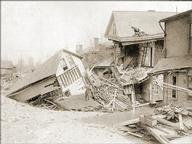Quiz Answer Key and Fun Facts
1. The 9.0 earthquake that struck off the northeast coast of Japan in 2011 actually moved the main island about how many feet?
2. The Japan 9.0 earthquake of March 11, 2011 was so intense that it ____________ Earth's spin and ____________ the length of the 24 hour day by microseconds (a microsecond = a millionth of a second).
3. The Richter scale had limitations when measuring the larger magnitude quakes and has been replaced by something called the Moment Magnitude scale which can accurately measure quakes up to a magnitude of 10.0.
4. The second largest earthquake in recorded history occurred in the USA on March 28, 1964 in which western state?
(I remember watching a film in school about the 49th state which included footage of this quake.)
5. The strongest earthquake in recorded history was a 9.5 and occurred on May 22, 1960 approximately 20 miles below the Pacific Ocean off the coast of which country did this happen?
(It sounds like a food or what you might say if you were cold.)
6. The effects of the tsunami associated with the Great Alaska earthquake of 1964 reached as far as Louisiana and South Africa.
7. On October 17, 1989 at 5:04 pm a 6.9 earthquake, known as the Loma Prieta quake, struck the San Francisco and Oakland areas and was seen by millions across the USA because it occurred just at the beginning of what nationally televised event?
8. The Earth's figure axis is not the same as the north/south axis around which it spins. What is the function of the figure axis in relation to the Earth?
9. The earth shakes every day and earthquakes are not at all unusual. On an average day how many measurable earthquakes occur around the world?
10. Most earthquakes occur in a region known as the ______ of Fire.
Source: Author
cleeclope
This quiz was reviewed by FunTrivia editor
gtho4 before going online.
Any errors found in FunTrivia content are routinely corrected through our feedback system.
